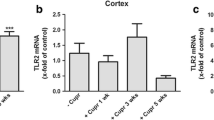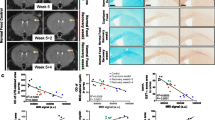Abstract
Multiple sclerosis (MS) is a chronic degenerative disease of the central nervous system that is characterized by myelin abnormalities, oligodendrocyte pathology, and concomitant glia activation. Unclear are the factors triggering gliosis and demyelination. New findings suggest an important role of the innate immune response in the initiation and progression of active demyelinating lesions. The innate immune response is induced by pathogen-associated or danger-associated molecular patterns, which are identified by pattern recognition receptors (PRRs), including the G-protein coupled with formyl peptide receptors (FPRs). Glial cells, the immune cells of the central nervous system, also express the PRRs. In this study, we used the cuprizone mice model to investigate the expression of the FPR1 in the course of cuprizone-induced demyelination In addition, we used FPR1-deficient mice to analyze glial cell activation through immunohistochemistry and real-time RT-PCR in cuprizone model. Our results revealed a significantly increased expression of FPR1 in the cortex of cuprizone-treated mice. FPR1-deficient mice showed a slight but significant decrease of demyelination in the corpus callosum compared to the wild-type mice. Furthermore, FPR1 deficiency resulted in reduced glial cell activation and mRNA expression of microglia/macrophages markers, as well as pro- and anti-inflammatory cytokines in the cortex, compared to wild-type mice after cuprizone-induced demyelination. Combined together, these results suggest that the FPR1 is an important part of the innate immune response in the course of cuprizone-induced demyelination.






Similar content being viewed by others
Abbreviations
- CC:
-
Corpus callosum
- CX:
-
Cortex
- FPR:
-
Formyl peptide receptor
- GFAP:
-
Glial fibrillary acidic protein
- Hc:
-
Hippocampus
- Iba-1:
-
ionized calcium binding adaptor molecule 1
- Itgam:
-
Integrin alpha M
- KO:
-
Lnock out
- PLP:
-
Proteolipid protein
- WT:
-
Wild type
References
Acs P, Kipp M, Norkute A, Johann S, Clarner T, Braun A, Berente Z, Komoly S, Beyer C (2009) 17beta-estradiol and progesterone prevent cuprizone provoked demyelination of corpus callosum in male mice. Glia 57:807–814
Barnett MH, Prineas JW (2004) Relapsing and remitting multiple sclerosis: pathology of the newly forming lesion. Ann Neurol 55:458–468
Barry A, Cronin O, Ryan AM et al (2016) Impact of exercise on innate immunity in multiple sclerosis progression and symptomatology. Front Physiol 7:194
Brandenburg LO, Koch T, Sievers J, Lucius R (2007) Internalization of PrP106-126 by the formyl-peptide-receptor-like-1 in glial cells. J Neurochem 101:718–728
Buschmann JP, Berger K, Awad H, Clarner T, Beyer C, Kipp M (2012) Inflammatory response and chemokine expression in the white matter corpus callosum and gray matter cortex region during cuprizone-induced demyelination. J Mol Neurosci 48:66–76
Bush TG, Puvanachandra N, Horner CH, Polito A, Ostenfeld T, Svendsen CN, Mucke L, Johnson MH, Sofroniew MV (1999) Leukocyte infiltration, neuronal degeneration, and neurite outgrowth after ablation of scar-forming, reactive astrocytes in adult transgenic mice. Neuron 23:297–308
Cattaneo F, Guerra G, Ammendola R (2010) Expression and signaling of formyl-peptide receptors in the brain. Neurochem Res 35:2018–2026
Cattaneo F, Parisi M, Ammendola R (2013) Distinct signaling cascades elicited by different formyl peptide receptor 2 (FPR2) agonists. Int J Mol Sci 14:7193–7230
Chen K, Le Y, Liu Y, Gong W, Ying G, Huang J, Yoshimura T, Tessarollo L, Wang JM (2010) A critical role for the g protein-coupled receptor mFPR2 in airway inflammation and immune responses. J Immunol 184:3331–3335
Clarner T, Buschmann JP, Beyer C, Kipp M (2011a) Glial amyloid precursor protein expression is restricted to astrocytes in an experimental toxic model of multiple sclerosis. J Mol Neurosci 43:268–274
Clarner T, Parabucki A, Beyer C, Kipp M (2011b) Corticosteroids impair remyelination in the corpus callosum of cuprizone-treated mice. J Neuroendocrinol 23:601–611
Clarner T, Diederichs F, Berger K, Denecke B, Gan L, van der Valk P, Beyer C, Amor S, Kipp M (2012) Myelin debris regulates inflammatory responses in an experimental demyelination animal model and multiple sclerosis lesions. Glia 60:1468–1480
Draheim T, Liessem A, Scheld M, Wilms F, Weißflog M, Denecke B, Kensler TW, Zendedel A, Beyer C, Kipp M, Wruck CJ, Fragoulis A, Clarner T (2016) Activation of the astrocytic Nrf2/ARE system ameliorates the formation of demyelinating lesions in a multiple sclerosis animal model. Glia 64(12):2219–2230. doi:10.1002/glia.23058
Du L, Zhang Y, Chen Y, Zhu J, Yang Y, Zhang HL (2016) Role of microglia in neurological disorders and their potentials as a therapeutic target. Mol Neurobiol. doi:10.1007/s12035-016-0245-0
Dufton N, Hannon R, Brancaleone V et al (2010) Anti-inflammatory role of the murine formyl-peptide receptor 2: ligand-specific effects on leukocyte responses and experimental inflammation. J Immunol 184:2611–2619
Fletcher JM, Lalor SJ, Sweeney CM, Tubridy N, Mills KH (2010) T cells in multiple sclerosis and experimental autoimmune encephalomyelitis. Clin Exp Immunol 162:1–11
Gao JL, Chen H, Filie JD, Kozak CA, Murphy PM (1998) Differential expansion of the N-formylpeptide receptor gene cluster in human and mouse. Genomics 51:270–276
Gao JL, Lee EJ, Murphy PM (1999) Impaired antibacterial host defense in mice lacking the N-formylpeptide receptor. J Exp Med 189:657–662
Goldberg J, Clarner T, Beyer C, Kipp M (2015) Anatomical distribution of cuprizone-induced lesions in C57BL6 mice. J Mol Neurosci 57:166–175
Hanke ML, Kielian T (2011) Toll-like receptors in health and disease in the brain: mechanisms and therapeutic potential. Clin Sci (Lond) 121:367–387
Hernandez-Pedro NY, Espinosa-Ramirez G, de la Cruz VP, Pineda B, Sotelo J (2013) Initial immunopathogenesis of multiple sclerosis: innate immune response. Clinical & developmental immunology 2013:413465
Hiremath MM, Chen VS, Suzuki K, Ting JP, Matsushima GK (2008) MHC class II exacerbates demyelination in vivo independently of T cells. J Neuroimmunol 203:23–32
Hochstrasser T, Exner GL, Nyamoya S, Schmitz C, Kipp M (2017) Cuprizone-containing pellets are less potent to induce consistent demyelination in the corpus callosum of C57BL/6 mice. J Mol Neurosci 61:617–624
Kettenmann H, Hanisch UK, Noda M, Verkhratsky A (2011) Physiology of microglia. Physiol Rev 91:461–553
Kilic AK, Esendagli G, Sayat G, Talim B, Karabudak R, Kurne AT (2015) Promotion of experimental autoimmune encephalomyelitis upon neutrophil granulocytes’ stimulation with formyl-methionyl-leucyl-phenylalanine (fMLP) peptide. Autoimmunity 48:423–428
Kipp M, Norkute A, Johann S et al (2008) Brain-region-specific astroglial responses in vitro after LPS exposure. J Mol Neurosci 35:235–243
Kipp M, Clarner T, Dang J, Copray S, Beyer C (2009) The cuprizone animal model: new insights into an old story. Acta Neuropathol 118:723–736
Kipp M, Norkus A, Krauspe B, Clarner T, Berger K, van der Valk P, Amor S, Beyer C (2011) The hippocampal fimbria of cuprizone-treated animals as a structure for studying neuroprotection in multiple sclerosis. Inflamm Res 60:723–726
Kipp M, van der Valk P, Amor S (2012) Pathology of multiple sclerosis. CNS Neurol Disord Drug Targets 11:506–517
Kipp M, Nyamoya S, Hochstrasser T, Amor S (2017) Multiple sclerosis animal models: a clinical and histopathological perspective. Brain Pathol 27(2):123–137. doi:10.1111/bpa.12454
Konat GW, Kielian T, Marriott I (2006) The role of Toll-like receptors in CNS response to microbial challenge. J Neurochem 99:1–12
Kutzelnigg A, Lassmann H (2014) Pathology of multiple sclerosis and related inflammatory demyelinating diseases. Handb Clin Neurol 122:15–58
Lehnardt S (2010) Innate immunity and neuroinflammation in the CNS: the role of microglia in Toll-like receptor-mediated neuronal injury. Glia 58:253–263
Lennon VA, Wingerchuk DM, Kryzer TJ, Pittock SJ, Lucchinetti CF, Fujihara K, Nakashima I, Weinshenker BG (2004) A serum autoantibody marker of neuromyelitis optica: distinction from multiple sclerosis. Lancet 364:2106–2112
Li L, Chen K, Xiang Y, Yoshimura T, Su S, Zhu J, Bian XW, Wang JM (2016) New development in studies of formyl-peptide receptors: critical roles in host defense. J Leukoc Biol 99:425–435
Mariani MM, Kielian T (2009) Microglia in infectious diseases of the central nervous system. J NeuroImmune Pharmacol 4:448–461
Mayo L, Quintana FJ, Weiner HL (2012) The innate immune system in demyelinating disease. Immunol Rev 248:170–187
Merres J, Höss J, Albrecht LJ, Kress E, Soehnlein O, Jansen S, Pufe T, Tauber SC, Brandenburg LO (2013) Role of the cathelicidin-related antimicrobial peptide in inflammation and mortality in a mouse model of bacterial meningitis. J Innate Immun 6(2):205–218. doi:10.1159/000353645
Migeotte I, Communi D, Parmentier M (2006) Formyl peptide receptors: a promiscuous subfamily of G protein-coupled receptors controlling immune responses. Cytokine Growth Factor Rev 17:501–519
Mishra MK, Yong VW (2016) Myeloid cells—targets of medication in multiple sclerosis. Nat Rev Neurol 12:539–551
Muller-Ladner U, Jones JL, Wetsel RA, Gay S, Raine CS, Barnum SR (1996) Enhanced expression of chemotactic receptors in multiple sclerosis lesions. J Neurol Sci 144:135–141
Oldekamp S, Pscheidl S, Kress E, Soehnlein O, Jansen S, Pufe T, Wang JM, Tauber SC, Brandenburg LO (2014) Lack of formyl peptide receptor 1 and 2 leads to more severe inflammation and higher mortality in mice with of pneumococcal meningitis. Immunology 143:447–461
Pasquini LA, Calatayud CA, Bertone Una AL, Millet V, Pasquini JM, Soto EF (2007) The neurotoxic effect of cuprizone on oligodendrocytes depends on the presence of pro-inflammatory cytokines secreted by microglia. Neurochem Res 32:279–292
Perrier S, Darakhshan F, Hajduch E (2006) IL-1 receptor antagonist in metabolic diseases: Dr Jekyll or Mr Hyde? FEBS Lett 580:6289–6294
Ransohoff RM, Brown MA (2012) Innate immunity in the central nervous system. J Clin Invest 122:1164–1171
Skripuletz T, Lindner M, Kotsiari A, Garde N, Fokuhl J, Linsmeier F, Trebst C, Stangel M (2008) Cortical demyelination is prominent in the murine cuprizone model and is strain-dependent. Am J Pathol 172:1053–1061
Skripuletz T, Gudi V, Hackstette D, Stangel M (2011) De- and remyelination in the CNS white and grey matter induced by cuprizone: the old, the new, and the unexpected. Histol Histopathol 26:1585–1597
Skripuletz T, Hackstette D, Bauer K et al (2013) Astrocytes regulate myelin clearance through recruitment of microglia during cuprizone-induced demyelination. Brain 136:147–167
Slowik A, Merres J, Elfgen A, Jansen S, Mohr F, Wruck CJ, Pufe T, Brandenburg LO (2012) Involvement of formyl peptide receptors in receptor for advanced glycation end products (RAGE) - and amyloid beta 1-42-induced signal transduction in glial cells. Mol Neurodegener 7:55
van der Star BJ, Vogel DY, Kipp M, Puentes F, Baker D, Amor S (2012) In vitro and in vivo models of multiple sclerosis. CNS Neurol Disord Drug Targets 11:570–588
van der Valk P, Amor S (2009) Preactive lesions in multiple sclerosis. Curr Opin Neurol 22:207–213
Acknowledgement
We thank Susanne Echterhagen and Lian Shen for the excellent technical assistance. This study was supported by the Else Kröner-Fresenius-Stiftung (LOB) and START-Program of the RWTH Aachen University (LOB).
Author information
Authors and Affiliations
Corresponding author
Ethics declarations
Conflict of Interest
The authors declare that they have no competing interests.
Rights and permissions
About this article
Cite this article
Bihler, K., Kress, E., Esser, S. et al. Formyl Peptide Receptor 1-Mediated Glial Cell Activation in a Mouse Model of Cuprizone-Induced Demyelination. J Mol Neurosci 62, 232–243 (2017). https://doi.org/10.1007/s12031-017-0924-y
Received:
Accepted:
Published:
Issue Date:
DOI: https://doi.org/10.1007/s12031-017-0924-y




